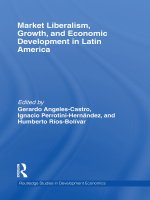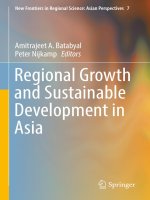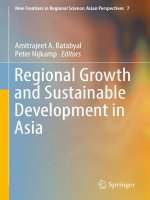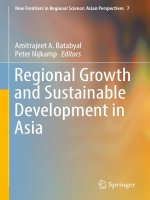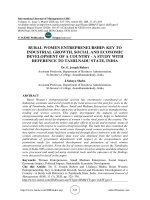Economic growth and economic development 54
Bạn đang xem bản rút gọn của tài liệu. Xem và tải ngay bản đầy đủ của tài liệu tại đây (87.54 KB, 1 trang )
Introduction to Modern Economic Growth
The other key agents in the economy are firms. Firms, like consumers, are
highly heterogeneous in practice. Even within a narrowly-defined sector of an economy (such as sports shoes manufacturing), no two firms are identical. But again
for simplicity, we start with an assumption similar to the representative consumer
assumption, but now applied to firms. We assume that all firms in this economy
have access to the same production function for the final good, or in other words,
we assume that the economy admits a representative firm, with a representative
(or aggregate) production function. Moreover, we also assume that this aggregate
production function exhibits constant returns to scale (see below for a definition).
More explicitly, the aggregate production function for the unique final good is
(2.1)
Y (t) = F [K (t) , L (t) , A (t)]
where Y (t) is the total amount of production of the final good at time t, K (t) is the
capital stock, L (t) is total employment, and A (t) is technology at time t. Employment can be measured in different ways. For example, we may want to think of L (t)
as corresponding to hours of employment or number of employees. The capital stock
K (t) corresponds to the quantity of “machines” (or more explicitly, equipment and
structures) used in production, and it is typically measured in terms of the value
of the machines. There are multiple ways of thinking of capital (and equally many
ways of specifying how capital comes into existence). Since our objective here is
to start out with a simple workable model, we make the rather sharp simplifying
assumption that capital is the same as the final good of the economy. However,
instead of being consumed, capital is used in the production process of more goods.
To take a concrete example, think of the final good as “corn”. Corn can be used
both for consumption and as an input, as “seed”, for the production of more corn
tomorrow. Capital then corresponds to the amount of corn used as seeds for further
production.
Technology, on the other hand, has no natural unit. This means that A (t), for
us, is a shifter of the production function (2.1). For mathematical convenience, we
will often represent A (t) in terms of a number, but it is useful to bear in mind that,
at the end of the day, it is a representation of a more abstract concept. Later we
will discuss models in which A (t) can be multidimensional, so that we can analyze
40
